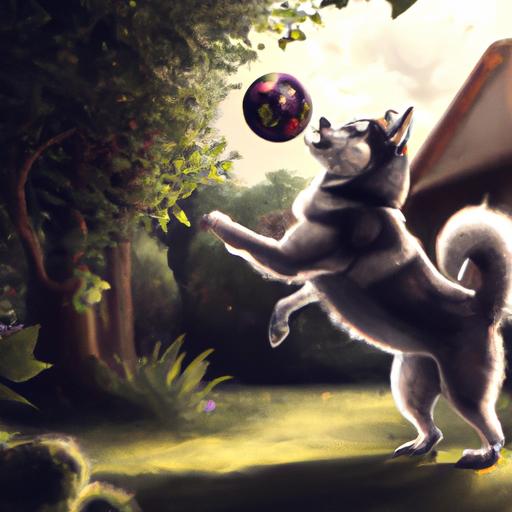Have you ever wondered where wild huskies roam? This curious, and sometimes mischievous, canine has had a long history, playing a significant role in human life.
In this article, we will explore the origins of the husky breed, where they live in the wild, the adaptations they have developed to survive in the Arctic, their social interactions, and how humans interact with wild huskies.
Prepare to discover the fascinating facts about wild huskies here.
Table of Contents
Where Do Huskies Live In The Wild?
Huskies are a breed of sled dog and are usually kept as pets, so they do not live in the wild.
In their natural environment, Huskies are found in the Arctic regions of the world, primarily in Siberia, Alaska, and Northern Canada.
History of the Husky Breed
For thousands of years, the Husky breed has been used by Arctic peoples for various purposes.
Believed to have originated in Siberia over 3,000 years ago, Huskies were bred by the Chukchi people as sled dogs, used to traverse the frigid tundra.
Their thick fur kept them warm in the bitter cold temperatures, and they were bred to be strong, intelligent, and loyal.
In the 20th century, Huskies were imported to Alaska and Canada, and began to be used in dog sled racing and other sporting events.
They have also been used as working dogs by the military and other organizations, and have become popular as family pets due to their intelligence and friendly nature.
Today, Huskies remain a popular breed for both working and recreational purposes.
They are known for their strength, endurance, and intelligence, and are still used to pull sleds in competitions and races.
They also make excellent companions and family pets, and their thick fur and strong build make them well-suited for colder climates.
Overall, Huskies have been an essential part of Arctic life for thousands of years, and their legacy continues to live on.
From their humble beginnings in Siberia to their current status as a popular pet and working dog, the Husky is a breed that will surely remain a beloved part of our lives for years to come.
Where Do Huskies Live in the Wild?

Huskies are one of the most impressive breeds of sled dogs found in the Arctic regions of the world.
From northern Canada, Alaska, Greenland, Siberia, and some parts of Europe, these dogs have been bred to survive in the most extreme climates.
With their thick fur coats and remarkable adaptation to the cold, they make for an ideal companion in the snow.
Huskies are highly social animals and usually live in packs.
Their family units are large and strong, and they hunt together for food in the wild.
Small animals, fish, and berries make up their diet, and they can often be found running around in the snow.
They are incredibly agile and can pull heavy loads over long distances.
In addition to their physical strength, huskies are known for their intelligence and loyalty.
They are highly trainable and form strong bonds with their owners.
They are also very friendly and love to play and interact with people.
Huskies truly are an amazing breed of sled dogs.
With their strength, intelligence, and loyalty, they make for great companions in the Arctic regions of the world.
Adaptations of Huskies to the Arctic
Huskies are some of the most impressive and hardy dogs in the world.
With their thick double coats of fur, they are well-equipped to handle the cold temperatures and strong winds of the Arctic.
Their fur acts as an effective insulation against the cold, and underneath this fur is a layer of fat that helps them retain body heat even in the coldest temperatures.
The Huskys anatomy is also well-suited for life in the snow.
They have a deep chest and wide feet, which helps them to walk on snow and ice without sinking.
They also have a special snow nose that helps them detect prey and other objects in the snow.
Furthermore, they have a special kind of night vision, which allows them to see in the dark and navigate the area even when the sun has set.
These animals are also equipped with a special type of metabolism that helps them conserve energy when temperatures drop.
This is why they are able to stay active and warm even when the temperatures drop.
They also have webbed feet, which helps them swim in icy waters and helps them move quickly over snow and ice surfaces.
Furthermore, their fur also helps them blend in with the snow and ice, making them difficult to spot in the wild.
Overall, the Husky is an incredible breed that is perfectly adapted to life in the Arctic.
Their thick double coat of fur, special metabolism, and other features make them masterful navigators in the snow.
Social Interaction of Huskies in the Wild

Huskies are incredibly social animals that live in packs in the wild.
Within their family group, they have a complex hierarchy, with the alpha as the leader and the beta as the subordinate.
To communicate with one another, these beautiful dogs use vocalizations such as barking and howling, as well as body language and scent marking to recognize each other.
They are incredibly loyal and protective of their pack and will cooperate and help each other when needed.
Huskies are very affectionate and playful with one another, often engaging in grooming and play activities.
Huskies are also highly territorial and will defend their pack from intruders or other animals.
They help one another hunt for food and will share their meals with the weaker members of their pack.
They travel together and work together to migrate to different areas seasonally, searching for food and shelter.
These amazing animals have an incredible bond with one another and are highly devoted to their family.
Human Interaction with Wild Huskies
Huskies have long been admired for their intelligence, loyalty, and playful nature.
For thousands of years, humans have bred huskies for sledding, as well as other tasks.
However, there are still some wild huskies that roam the Arctic regions.
Depending on the region and population, humans interact with wild huskies in a variety of ways, from hunting them for their fur and meat, to developing more co-existing relationships.
In some cases, humans have attempted to capture and domesticate wild huskies.
Unfortunately, this is not usually successful, as wild huskies are used to surviving in a harsh, wild environment and may have difficulty adjusting to domestication.
However, some wild huskies have been adopted by humans and become stray dogs that are taken in and domesticated.
Huskies have been domesticated by humans for millennia.
They form strong, deep bonds with their owners and are well-suited to the climate and terrain of the Arctic regions.
Wild huskies can be found in remote areas, and while some will not approach humans, others can become friendly with people.
The effects of human interaction with wild huskies can differ depending on the individual dog and the type of interaction.
From sledding to survival, huskies have had a long history with humans.
Their intelligence, loyalty, and playful nature have made them widely adored, and their ability to thrive in the Arctic regions has made them invaluable to those who live in the area.
Even today, wild huskies still roam the Arctic and interact with humans in various ways, creating a unique bond between man and dog.
Final Thoughts
Wild huskies are a fascinating breed of sled dog that have adapted to the extreme Arctic climates of northern Canada, Alaska, Greenland, Siberia, and parts of Europe.
They are highly social animals that live in packs, making them a great choice for companionship in the home.
Now that you know more about where wild huskies live and how they interact, why not consider adopting one? With a bit of research, you can find an organization that rescues huskies and provides them with a loving home.

